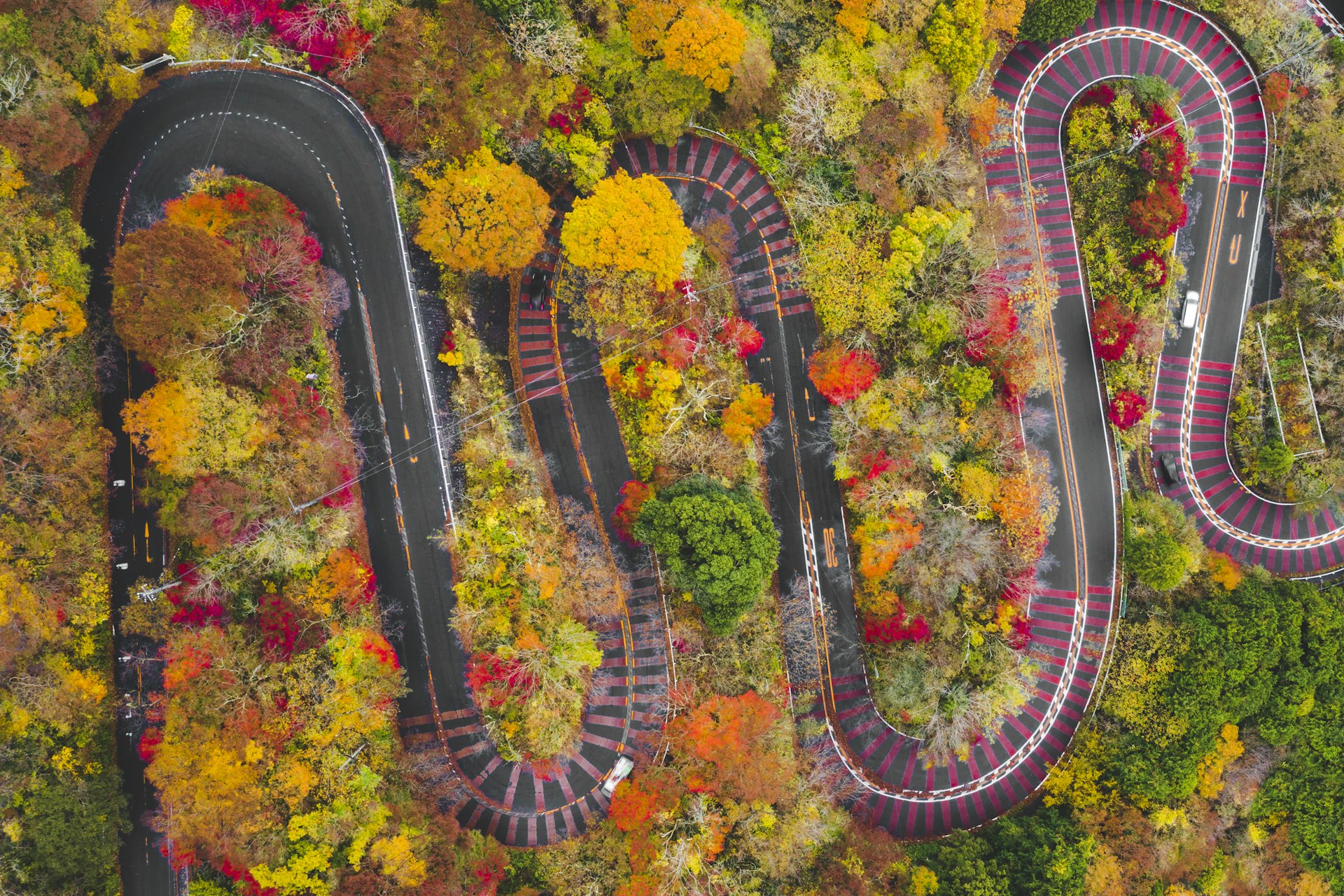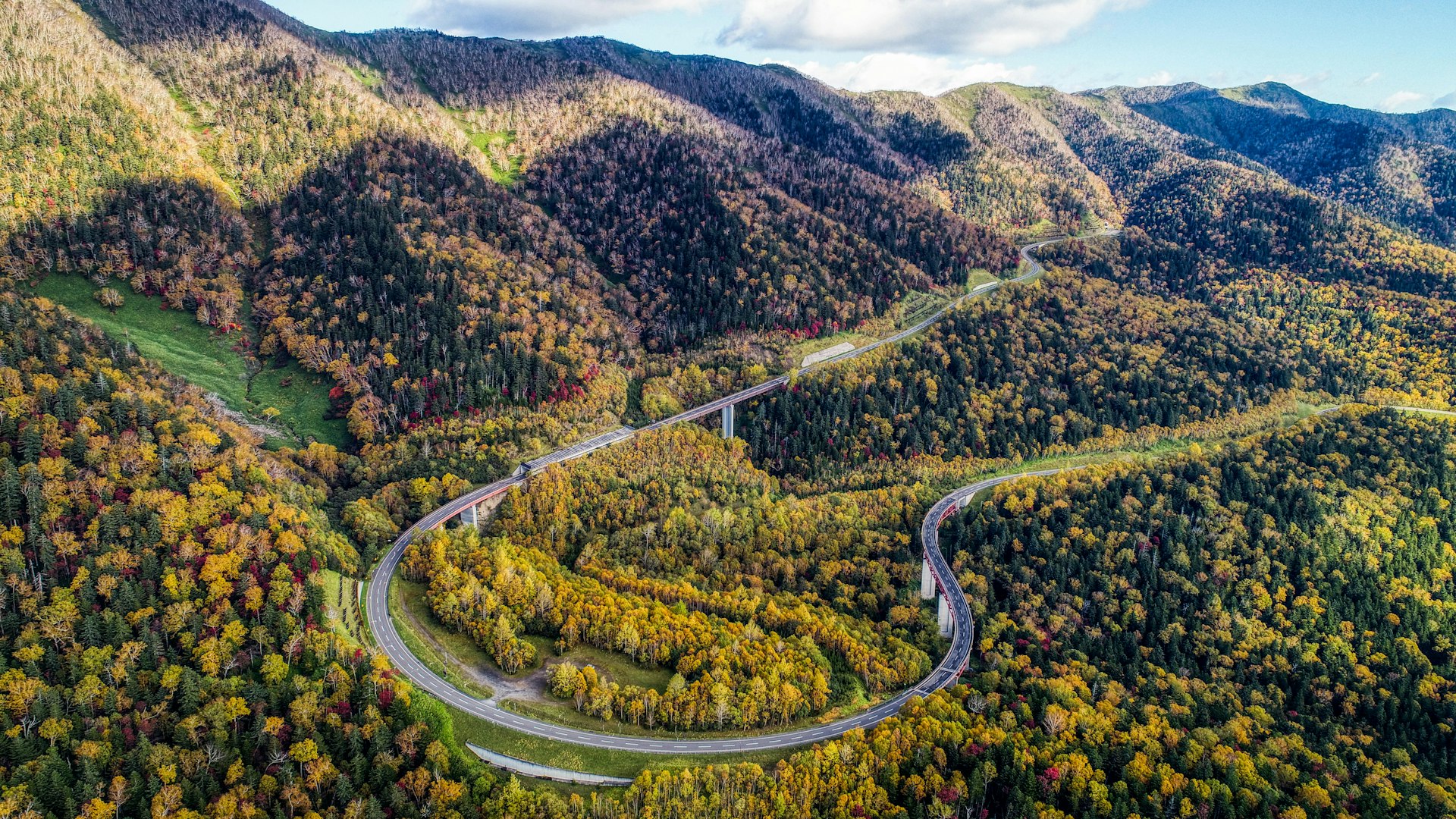As an island nation with nearly three-quarters of its terrain smothered in mountains, Japan seems custom-built for scenic road trips.
Whether you’re swerving along the asphalt in the wild and expansive north, skirting the towering bluffs and wave-battered coasts of western Honshu, or winding through the archipelago of the Inland Sea, you can’t beat the freedom of being behind the wheel. So buckle up for our ten favorite road trips in Japan.
1. Coast-to-Coast Hokkaido
Best for gorgeous northern countryside
Rausu – Hakodate; 700km (435 miles)
Hokkaidō, Japan’s northernmost island, is a driver’s dream: vast, untamed, sparsely populated and veined with quality roads (though they’re best avoided in the snow-dumped winter). The recommended coast-to-coast drive traverses over 400 miles of open road from the Unesco-recognized Shiretoko Peninsula in the east to the old colonial port town of Hakodate in the west.
It’s a journey best savored, given the wealth of natural scenery and worthwhile diversions: the 17-mile pencil-straight “Road to Heaven” highway (天に続く道); the calderas and primeval forests of Akan-Mashū National Park; the Roller Coaster Road zigzagging vertically through the pastoral farmlands of Biei; and Sapporo, a lively entertainment hub and the largest metropolis north of Tokyo.
2. The Seto Inland Sea along the Shimanami Kaidō
Best for scenic island-hopping via suspension bridge
Onomichi – Imabari; 70km (43 miles)
A popular cycling and scenic driving route, the Shimanami Kaidō traces lazy ‘S’ shapes along the Seto Inland Sea via wind-whipped suspension bridges and island villages lost in time. Drivers who move at a leisurely pace will be rewarded with watercolor views of the Inland Sea haze silhouetting the many humpbacked islands contained within it.
For a detour you won’t forget, check out Kōsan-ji, a singularly kitschy temple on the island of Ikuchi-jima. This garish religious monument fuses a litany of architectural styles, from Italian marble foundations to ancient Chinese iconography.

3. Izu Peninsula to Hakone
Best drive from oceanside to Mt Fuji highs
Minamiizu – Hakone; 115km (71 miles)
The epic route from Izu Peninsula to Hakone is a favorite among driving enthusiasts. From the Izu Peninsula’s southern tip, the coastal highway passes through Shimoda, a surfers’ haunt and historic port town, and Higashiizu, site of the fabled moon road power spot where waxing moons trace a beam of light across the Pacific, supposedly imbuing any witness with a divine energy. Further north, the road hugs the shores of Lake Ashi in Hakone, from where you’ll get scintillating views of Mt. Fuji on a clear day.
Finish this road trip in style on the Hakone Skyline, a famously twisty tōge (mountain road) that served as an inspiration for Hollywood movie The Fast and the Furious: Tokyo Drift (though the actual mountain drift race scenes in the film were shot in LA). The driftway is one of 30-plus “Melody Roads” in Japan – so named for the tactile grooves which emit musical notes as tires roll over them.
4. The Noto Peninsula Drive: Takaoka to Kanazawa
Great for dramatic coastal seascapes
Takaoka – Kanazawa; 236km (147 miles)
From the picture-perfect sunrise of Amaharashi Beach to the bracing coastline of Ishikawa Prefecture, this road trip throws down some of Japan’s finest coastal scenery.
The route centers around Noto, a dark, rugged peninsula home to solemn shrines and dramatic seascapes. In west Noto, you’ll also find the Shiroyone Senmaida rice terraces tumbling down toward the sea, and the port city Wajima with its 1000-year-old morning market. Finish the journey in Kanazawa, a former samurai stronghold and custodian of Japan’s traditional arts and crafts. The city is home to a number of enlightening museums, including the impressive 21st Century Museum of Contemporary Art.

5. Coastal Wakayama
Best castle and sacred trails
Wakayama City – Shingu; 180km (112 miles)
Wakayama prefecture sits on the bulbous Kii Peninsula south of the Osaka-Kyoto conurbation and is the gateway to the misty forests of the Kumano Kodō pilgrimage trail.
The 100-plus-mile coastal road skirts by Wakayama’s 16th-century feudal castle and the onsen (hot spring) resort town of Shirahama, where evening suns set behind the moon-shaped hole of Engetsu-to Island. The toothy rock features and soaring cliffs of Kushimoto in the south will equally vie for your attention before the route culminates in Shingu on the Mie Prefecture border, where Kamikura Shrine marks the spot upon which Japan’s Shinto gods first descended to the earth.
6. Central Western Japan: Shimane to Kyōtango
Great for cool geology, chill coastline and an ancient shrine
Iino-Ura – Ine; 355km (22o miles)
The 220-mile scenic drive from Iino-Ura (Shimane) to Ine (Kyōtango) snakes between dense forests and a sparsely populated, green-swept coastline. Along the way, you’ll hit Izumo, home to one of Japan’s oldest shrines (Izumo Taisha), the sparkling bay of Lake Shinji in Matsue City, and Japan’s only large dune system at Tottori’s San’in Kaigan Geopark.
In the Kyōtango region, rolling hills and crystal blue waters set the scene for your final destination: Ine, a picture-book village famed for its funaya (fishing boat houses) built on stilts above the shore.

7. Kyūshū: Mt. Aso to Cape Sata
Best for soaking up subtropical volcanic vibes
Mt. Aso – Cape Sata; 322km (200 miles)
Drive through the rolling grasslands of Kumamoto to find Japan’s largest caldera and active volcano, Mt. Aso. The Aso Panorama Line offers the best course, weaving along the caldera’s outer rim and perpetually casting its gaze toward the belching volcano in the middle.
From Aso, head south along the spine of Kyūshū toward the most southern tip of Japan’s four main islands, Cape Sata. Before you arrive at the observatory pinned to the Pacific coast, consider a night at one of the many onsen towns en route, or an overnight stay in the laidback subtropical city of Kagoshima to enjoy some black pork, sweet-potato shōchū (distilled liquor) and views of volcano Sakurajima seemingly floating on the bay.
8. Tōhoku
Best for exploring Japan’s rural backroads
Fukushima City – Aomori City; 335km (208 miles)
Tōhoku, a region whose name means “northeast,” is webbed in immaculate driving roads which carve through its national parks, virgin forests, and the towns and cities still recovering from the 2011 Great East Japan Earthquake.
The 200-plus-mile journey from Fukushima to Aomori swerves past the green-coated islets of Matsushima Bay – said to have put the 17th-century father of Japan’s haiku poetry, Matsuo Bashō, at a loss for words – and the foamy seascapes and knobbly sea stacks of the 1000km-long Michinoku Coastal Trail. Top detours include the winding road to the large volcanic crater lake at Mt Zaō in Miyagi Prefecture, and the road circumnavigating Aomori’s pristine Lake Towada, whose serene waters you can paddle by kayak.
9. Shikoku’s 88 Temples Pilgrimage
Best for meditative magic, secret surf spots and solitude
Naruto – Sanuki; 1200km (745 miles)
It may seem antithetical to embark upon a pilgrimage on four wheels. But with 88 individual temples to discover along 1200 kilometers of terrain on the Shikoku Henro (Pilgrimage) – dedicated to the founder of Shingon Buddhism, Kōbō Daishi – you’re going to want all the help you can get.
Entering from Kōbe along the Akashi-Kaikyo Bridge, the world’s longest suspension bridge with a main span of two kilometers, is recommended for jaw-dropping sea-to-coast vistas. The temple route traverses all four Shikoku prefectures, passes through its most bustling port cities, and encourages plenty of stops for bucolic forest walks, onsen soaks and short temple sojourns. If you get lost, keep your eyes peeled for white-clothed pilgrims replete with bamboo walking sticks trudging along the roadsides.
10. Tsushima
Best for remote historic sites and isolated beauty
Cape Tsutsu – Kankoku Observatory; 70km (43 miles)
With limited access to public transport and abounding in lush coastal scenery, a road trip is perfect for exploring Tsushima, the titular island setting the scene for the critically acclaimed 2020 PlayStation game Ghost of Tsushima.
Though only 43 miles north-to-south, the small island bisecting the Korea strait is teeming with natural and manmade wonders: the Kaneda Fortress ruins, the lonely Watatsumi Shrine, islet-littered Aso Bay, and the Korean-style Kankoku Observatory on the island’s northern tip, which, on a clear day, provides views of Busan in South Korea. Day hikers can summit one of Tsushima’s forested peaks, while its rivers and beaches offer plenty of inviting spots to relax along your island drive.
